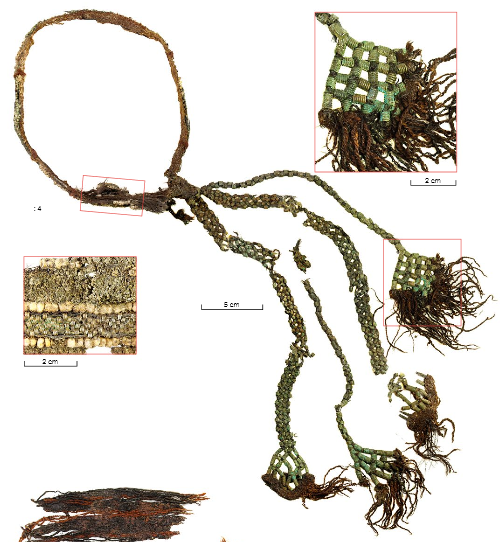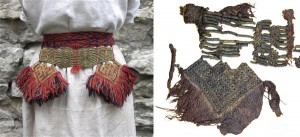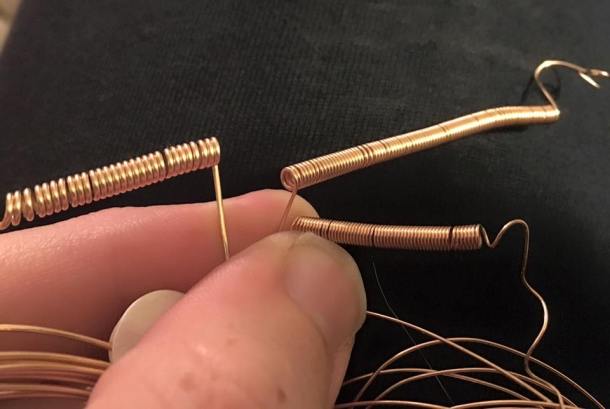Introduction
Given all the work I’ve been doing on the Lochac history display recently, I’ve had little time or inspiration to make anything so far this year. Having said that, this first post for 2016 is based on yet another random direction that has recently taken my interest, something I’ve been looking into in snippets of spare time.
I was checking my Facebook newsfeed when, lo and behold, an absolutely gorgeous work in progress by Duchess Siobhan of a Finnish bronze coil decorated apron caught my eye. I asked her some questions about it, curious as to how she was weaving these decorations, and she kindly answered them and sent me some short videos to give me an idea of the method she uses to weave the coils together.
My enthusiasm and curiosity were picked and lead me down a virtual rabbit hole of searching for more about this type of decoration.
Background
The first thing that I realised was that these bronze coil decorations were not restricted to Finland; in fact, they were a distinctive element of clothing decoration observed in finds from the Baltic countries (including Finland, Estonia, north-western Russia, Latvia, and Lithuania). I trawled through many Finnish and Latgalian (eastern Latvia) examples before coming across some Estonian finds, which immediately caught my attention.
Some images I’ve found so far of extant finds, museum reproductions, and recreational reproductions of Baltic wire coil decorations can be seen in my pinterest album: 11-14th Century Baltic Costume. Others can be seen in the detailed grave finds and articles I’ve referenced at the bottom of this post.
Bronze spirals/coils appear to have been used prolifically in clothing and accessories in Estonia from the 10th to the 19th centuries (Rammo and Ratas, 2015). So far, I’ve seen these coils used on elaborate headbands with tails ending in tassels, tasselled shawls, intricate belts, and garters. The striking, colourful designs appeal to me immensely, and I am particularly enthralled by the headbands of bronze coils, yellow beads, and colourful tassels.
The headbands and belts are of particular interest to me, and so I’ve decided to start with these. What appeals to me most are their quirkiness/uniqueness, the use of colours and shiny things (yes, I was probably a bowerbird in a previous life), and that I don’t think I’ve seen anything like this before around Lochac or Pennsic.

Estonian headband grave find, page 39, Valk et. al 2014.

Estonian headband grave find, page 168, Valk et. al 2014.

Estonian headband reconstruction in the Estonian Museum, photo by Mervi Pasanen (2015).

Reproduction and extant Estonian bronze coil belt, Rammo and Ratas 2015b.
Part 1: First Attempts
Unfortunately, there don’t appear to be any easily-accessible bronze coils for sale – which I discovered after searching the interwebs and asking people who’ve made bronze coil decorated items before. So, I had to figure out how to make my own and what to make them with.
I ended up finding a coiling jig on etsy that is used in jewellery making. The jig is used 100% manually and is quite easy to use, actually. Some people I know have made coils using drills, but I’m not so thrilled about trying that on my own… so, manual it is.

Me using my new coiling jig. I didn’t have a vice grip handy so I just held it between my knees. A little awkward, but it worked (Ceara Shionnach, 2016).
Deciding on what gauge of bronze wire to use wasn’t easy, but was helped by the detailed grave finds (Valk et. al 2014). I had bought a bronze wire sampler of 18 to 26 gauge wire from etsy, and played around to see the differences in size and appearance.

I made several short coils to test the different gauges of wire using the smallest mandrel in my coiling jig. This is 20 gauge, 24 gauge, and 26 gauge (left, right, bottom) (Ceara Shionnach, 2016).
Using some of the headband images that have bronze coils with a size key included, I estimated approximately 1mm wide wire was used in the bottom of an extant tassel (Estonian headband grave find, page 39, Valk et. al 2014) to make 6mm long coils. This translates to approximately 20 gauge wire. It appears that the bronze spirals from finds do vary in length and gauge, so I’ll need to look more into that as I progress with my exploration.

34 coils at 6 rotations each (~6mm long) took about 2 hours (Ceara Shionnach, 2016).
In 2 hours (whilst concurrently watching tv series), I managed to turn 7 feet of 20 gauge bronze wire into 34 bronze coils of approximately 6mm (i.e. 6 rotations per coil) in length. First, I made one long coil. Then, separating the coil at every sixth rotation, I clipped the large coil into pieces. These pieces were then individually put back onto the mandrel of the coiling jig and manipulated back into a tight coil using pliers, ensuring that the cut ends were tucked in.
I’ve now bought some more 20 gauge wire and am waiting for it to ship, then I’ll make more coils for my first project (a headband tail and tassel). I trialed some wool I have handy for weaving with, but it broke too easily so I’ll need to find something sturdier to give it a better try.
Part 2: Headdress Tails
References
Many of these references are (unsurprisingly) written in Estonian. I’ve been relying on Google Translate to understand the gist of the text (I know that’s not ideal), however, there are many tables and images analysing extant finds with measurements on them that are easily understood in English. My tips so far for finding relevant materials on this subject, which are often written in Estonian, is to search for keywords such as: spiraaltorudest kaunistused (coil tubing ornaments), pronksspiraalid (bronze), pronksspiraalkaunistused (bronze decorations), 14. Sajandil (14th century), and Siksälä (a reference to an Estonian place with many finds relating to this subject).
Lang, Valter (2007). Estonian Archaeology Volume 3: The Bronze and Early Iron Ages in Estonia. 298 p. ISBN 978-9949-11-726-0.
http://www.tyk.ee/ea
Mervi Pasanen (2015). Hibernaatiopesäke: Pronssia ja Ihanuutta / Eesti Rahva Muuseum / Bronze and Awesomeness.
http://hibernaatio.blogspot.com.au/2015/05/pronssia-ja-ihanuutta-eesti-rahva.html
Rammo, Riina (2005). PRONKSSPIRAALKAUNISTUSED RÕIVASTEL EESTI HAUALEIDUDE PÕHJAL 11. – 14./15. SAJANDIL (Bronze decorations grave finds of Estonia’s clothes based on 11-14/15th century). Published by the University of Tartu (Estonia).
www.arheo.ut.ee/docs/Riina_Rammo_bakalaureus.pdf
Rammo, Riina and Ratas, Jaana (2015a). Ühte kadunud tehnikat taastades: spiraaltorudest
kaunistused rõivastel (A Lost Technique: Spiral Tube Garments and Ornaments). Published in Silmnähtav – The Manifest by Viljandi Kultuuriakadeemia (Viljandi Culture Academy), pp65-97. ISBN-10: 998540940X, ISBN-13: 9789985409404.
http://ojs.utlib.ee/index.php/SV/article/download/12596/7687
Rammo, Riina and Ratas, Jaana (2015b). Virunukast leitud tagapõlle jäänused ja rekonstruktsioon. Valmistas Jaana Ratas. (Virunukast tagapõlle found the remains and reconstructions. Manufactured by Jaana Ratas). Published by Sirp.
http://www.sirp.ee/s1-artiklid/c21-teadus/killud-pikast-traditsioonist-spiraaltorud-roivastel/
Tvauri, Andres (2012). Estonian Archaeology Volume 4: The Migration Period, Pre-Viking Age, and Viking Age in Estonia. 384 p. ISBN 978-9949-19-936-5.
http://www.tyk.ee/ea
Valk, Heiki and Laul, Silvia (2014). Siksälä kalme I, Muistis ja ajalugu (Siksälä mound , Artefacts and History). Published by the University of Tartu (Estonia).
http://www.arheo.ut.ee/docs/siksali-I-veebi-.pdf
Valk, Heiki, Ratas, Jaana, and Laul, Silvia (2014). Siksälä kalme I, Matuste ja leidude kataloog (Siksälä mound , uncertainties and findings directory). Published by the University of Tartu (Estonia).
http://www.arheo.ut.ee/docs/siksali-II-veebi_.pdf